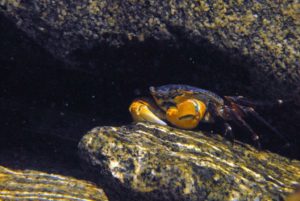David Muirhead recently posted this crab photo on his Facebook page: –
(Taken at Point Dutton (northwest of Coffin Bay) in March 2012)
He wrote, “These large and gaudy crabs are favourites of mine. They only inhabit the intertidal zone (mainly northwest of about Coffin Bay in SA) and are beautiful to behold as they watch inquisitively from the safety of large jagged granite boulders and crevices with their carapace washed over by the gentle wind ripples and slight swells that manage to ruffle the otherwise mirror smooth surface of the crystal clear rock pools found along many parts of this remote coastline.”
He went on to say, “This crab is approximately the same size and weight as a blue swimmer crab! (I’m guessing about the weight comparison but I am certain about the size! So much so, I am a bit perplexed as to why nobody has chosen them as a regional tourism promotional icon! Honestly they are spectacular crabs and easily seen in delightful rock pools and tide pools of that western section of coast.”
A reposting of the crab photo on David’s Facebook page caused me to ask, “What species is this?” This led to some discussion about the species and checking of reference books, etc… David subsequently came up with the following details about the crab: –
(It is) “Leptograpsus variegatus and the photo is the yellow variant. Common name, would you believe, is Purple Shore Crab (but the taxonomic species name is perfect)!”
He then added, “but I am rather surprised to see the stated maximum carapace width of this very widely distributed subtropical shore crab is 80mm. I will have to go back to Point Dutton and refresh my memory with regard to the size of the crabs there because I have already claimed that they are as big as, or nearly as big as, the (roughly equally widespread through subtropical oceans) blue swimmer crab, Portunus pelagicus and I will be embarrassed to be proven wrong.”
He later posted, “Hmm, not as uncommon a thing as I would have friends believe! Correctly spelled as Leptograpsus. (And I have overestimated the size of the ones I photographed northwest of Coffin Bay five years ago! But the carapace is quite small compared with the overall width of the body and especially once you factor in the extra ‘meaty solidity’ afforded by the closely grouped legs on each side behind the big bright main nippers?”
At some stage, I told David, “Leptograpsus variegatus is illustrated on p.507 of “Marine Decapod Crustacea of Southern Australia – A Guide to Identification” by Gary CB Poore (but no photo).
David later told me, “The crab also features on pages 214-5 in the revised edition of “Australian Marine Life – The Plants and Animals of Temperate Waters” by Graham J Edgar (and it is heavily harvested in NSW for fishing bait!).”
He later posted, “Maximum carapace width 80 mm versus 110 mm for blue swimmer crabs, so I wasn’t too far off the mark when I said the ones at Point Dutton were almost as big!”
Another post by David reads, “And I am now aware of just how widely distributed this taxon is; Most of the world’s subtropical oceans wherever they meet (mainly rocky) coastline. How about the common name Purple Shore Crab?!
No wonder I took ages to get an accurate provisional ID for the yellow form which, as far as I’m aware, is the only colour variant of the species I’ve seen here in South Australia. Surely I must have seen the purplish or other coloured crabs of the same species (?? species complex??) in my travels to other subtropical regions. But I would not have known their identity nor taken photos of them, so any body’s guess!”



Perhaps “passionfruit shore crab” would be a more useful common name? FYI, I’ve seen and photographed these at various locations on Kangaroo Island, including: Hanson Bay, Harvey’s Return, Antechamber Bay and Vivonne Bay. I made several sighting reports (and submitted photos) to the Atlas of Living Australia in recent years.
Good work Dan.